In my last article, we saw that artificial intelligence is getting better and better at answering our questions, regardless of the subject matter or the sector.
Using GPT-3 technology, I demonstrated that an AI can successfully pass an SEO multiple-choice test as well as solve SEO case studies.
There are other, even more advanced, technologies, such as Deepmind’s Gopher, which outperform GPT-3 in the following fields: Humanities, social sciences, medicine, science, and math.
The following graph highlights the accuracy of the answers provided by Gopher, UnifiedQA, GPT-3, and a human expert.
Depending on the subject, we can see the narrow gap between the level of the AI and that of an expert.
This also suggests that the AI could potentially exceed the level of a non-expert person.
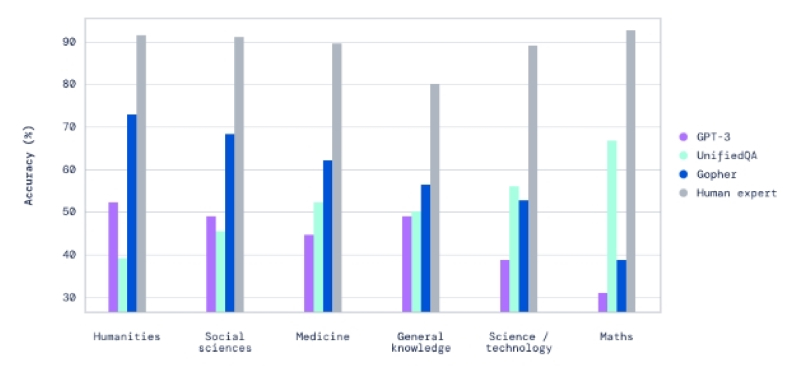 Image from Deepmind, June 2022
Image from Deepmind, June 2022Presently, AI can be a useful supporting resource for many marketing topics.
Let’s take a look at how to work with AI and more importantly, how to integrate it into your business.
4 Ways To Interact With An AI Tool
We will focus on the main methods of interaction to successfully set up the best AI-human combination.
1. Using Your Web Browser
The most interesting kind of interaction is to plug the AI into your back-office or into your web browser with a Chrome plugin.
There are numerous potential applications, as you will be able to help your users with advanced projects like document classification, writing assistance, meta-tag generation, text extraction, and even suggesting new topics.
You can connect the AI to your tools via a simple Javascript call asking it to perform specific tasks.
Below is an example of a JS integration with GPT-3.
The example is oversimplified to show you that with 20 lines of code and the appropriate instructions, you can easily connect a language model like GPT-3.
var xhr = new XMLHttpRequest();
xhr.open("POST", 'https://api.openai.com/v1/engines/text-davinci-002/completions');xhr.setRequestHeader("Content-Type", "application/json");
xhr.setRequestHeader("Authorization", "Bearer sk-RkXXXXXXXXXXXXXXXXXXXXXXXX");xhr.onreadystatechange = function () {
if (xhr.readyState === 4) {if (xhr.status==200){
var data=xhr.responseText;
var jsonResponse = JSON.parse(data);
answerGPT3 = jsonResponse["choices"][0]['text'];
console.log(answerGPT3);
}
else {
console.log('API error');
console.log(xhr.responseText);
}
}};var prompt = "List 50 concepts about … "
var data = `{
"prompt": "PROMPT",
"temperature": 0,
"max_tokens": 256,
"top_p": 1,
"frequency_penalty": 0,
"presence_penalty": 0
}`;data = data.replace('PROMPT', prompt)
xhr.send(data);
If your back-office supports Javascript and you have seasoned developers, integrating advanced AI features has never been easier.
In order to test this initial connection, create a Chrome plugin to evaluate an AI on its capacity to correctly respond to certifications designed for experts.
To do this, use a Chrome plugin that allows optical character recognition to capture any kind of text.
Then, leverage a separate Chrome plugin that modifies a page’s CSS to make the page as understandable as possible.
In an example exercise, we assigned each answer of a multiple-choice test to a corresponding letter.
Then, with the previous 20 lines of code, we sent the instructions to the AI to generate the results in a text field.
With this program, called “Asimov’s tests,” the AI managed to pass several certifications.
I then tested the AI on the subject of medical science and it attained scores of more than 60%, without any previous training in a specific discipline.
This confirms that by choosing your subject correctly, the results produced by the AI can strongly help your teams to improve day-to-day work.
 Image from LinkedIn, June 2022
Image from LinkedIn, June 20222. Using Your Data Visualization Tools
Over the past few months, tools that generate documentation or facilitate code writing have started to appear.
One remarkable use case is to simply generate dashboards or SEO tools with instructions.
There are now open source tools like Streamlit that have very advanced components in Data Visualization or Data Manipulation.
By providing the appropriate instructions, it is easy to request the generation of an app that interacts directly with your data.
For example, you can generate a web application with a complete interface and functional code.
This practice is quite recent, because we use language models that are exclusively fed with computer code. And again, the results are quite impressive.
In the following graph, you can see all the most popular code generators and the data with which they were created.
- CodeParrot: 50 GB.
- GPT-3 Codex: 159 GB.
- InCoder: 216 GB.
- PolyCoder: 249 GB.
- AlphaCode: 715.1 GB.
- CodeGen: 1.38 TB.
It is possible to generate applications in many languages; the main ones are Java, C, JS, and PHP.
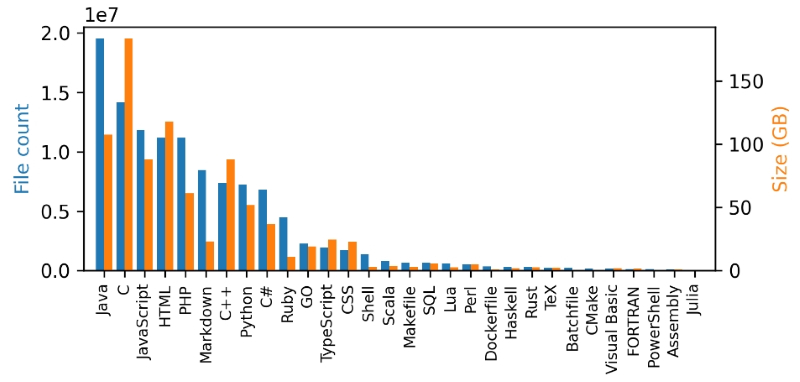 Image via Huggingface.co, June 2022
Image via Huggingface.co, June 2022Whether you’re a beginner or an expert, I encourage you to give it a try – as the AI can create your SQL query or your graphs in a matter of seconds.
Practical use is important if you want to get better at using your favorite tools.
3. Using A Chatbot
You can also create a chatbot to answer very specific questions by clearly specifying what role it should play in the instructions.
Here, I ask the chatbot to respond as if it were a doctor, while also using a touch of kindness and humor.
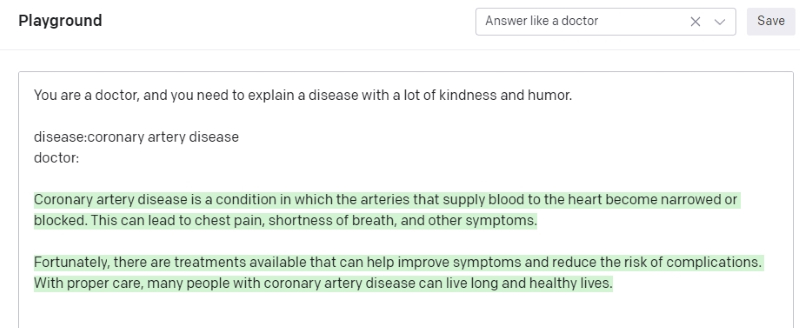 Screenshot by author, June 2022
Screenshot by author, June 2022AI-based chatbots can therefore provide personalized advice and recommendations based on customer preferences. Don’t hesitate to tailor the AI to respond in a particular manner.
A great example is that of Danny Richman, who created an AI version of Google’s John Mueller, called MuellerBot.
This bot builds on the above principle to answer SEO questions as if John Mueller himself were answering them.
It’s both fun and unsettling, as the answers can be quite accurate.
-
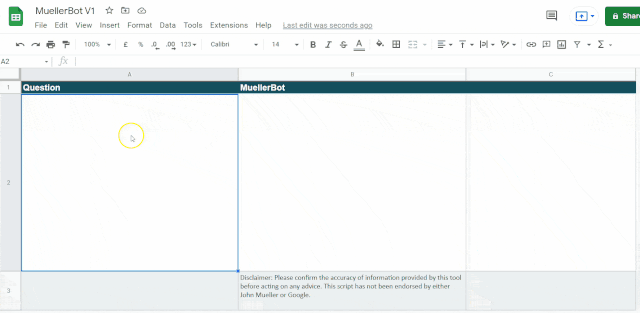 Image from Danny Richman, June 2022
Image from Danny Richman, June 2022
4. Using An AI Assistant Program
Lastly, AI assistants for SEO are programs that run in the background and apply SEO fixes if a page is poorly constructed or has classic errors.
The first such applications date back to 2016, when Facebook was implementing bug auto-fixes with Getafix.
Based on all the bugs fixed in the past, the assistant prepares correction templates that are applied and reviewed by a human before being rolled out.
This is very applicable in SEO, where we know that concerns about meta tag titles, descriptions, pagination, and links are typical problems.
 Image from engineering.fb.com, June 2022
Image from engineering.fb.com, June 2022To do this, you can use GPT-3 in edit mode and modify the SEO pages using the appropriate instructions.
Below are my instructions:
- Add a title with an H1 tag at the beginning of the text.
- Add an <a href> link to the most important word in the body of the text.
- Create useful outlinks at the end of text by using <ul><li>.
- Add a YouTube video in the body of the text.
- Put the top five concepts in bold.
 Screenshot from OpenAI, June 2022
Screenshot from OpenAI, June 2022If we study the generated text, we can see that the results are excellent: The H1 title sums up the article, the words in bold are accurate, and the YouTube video and outbound links are relevant to the theme.
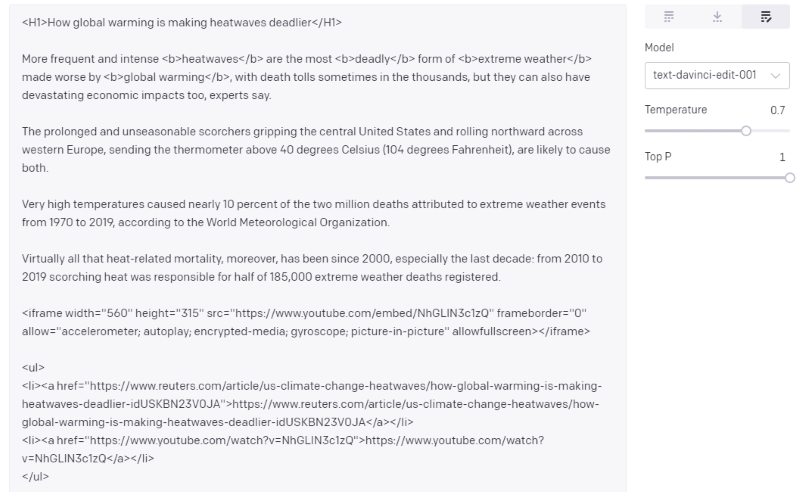 Screenshot from OpenAI, June 2022
Screenshot from OpenAI, June 2022In short: Your AI assistant can save you a lot of time.
Just a note: The links are all dummy links, but you can connect everything to a link database and use mapping tables to replace LINK1 with a link in your database or CSV file.
Now, you can appreciate the potential of automating these types of tasks.
Now that you know the different ways of interfacing a language model with your existing tools, don’t hesitate to implement the method(s) that works best for you, such as:
- Chrome Plugin.
- Directly into your CMS.
- Via a chatbot.
- Data visualization.
- AI Assistant.
More resources:
Featured Image: Graphic farm/Shutterstock
